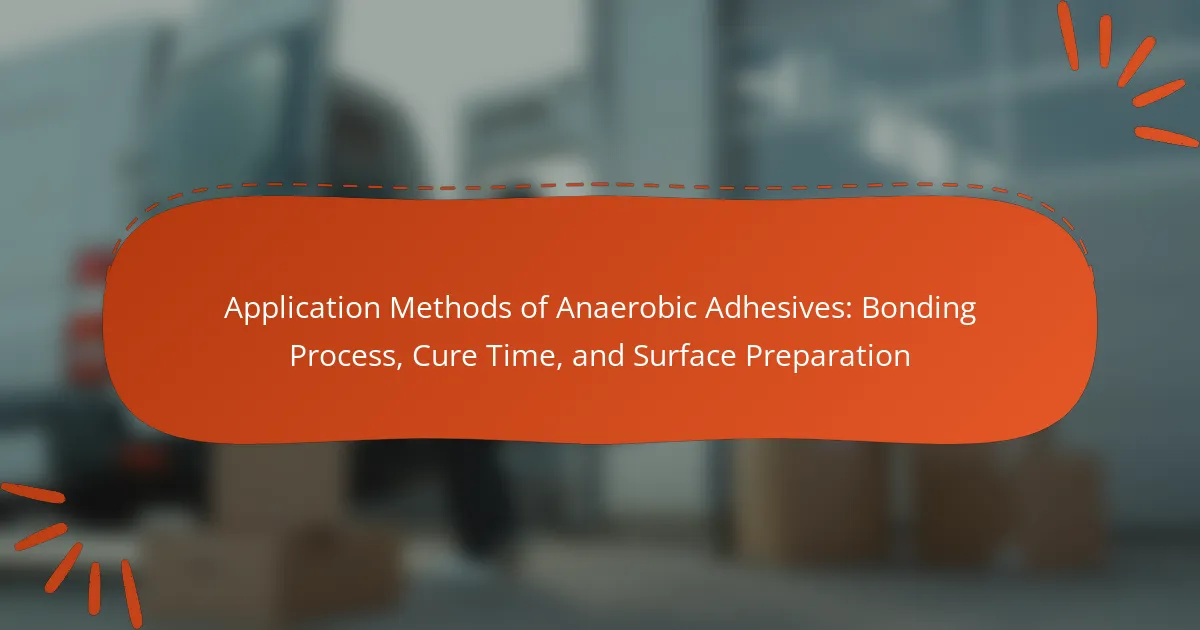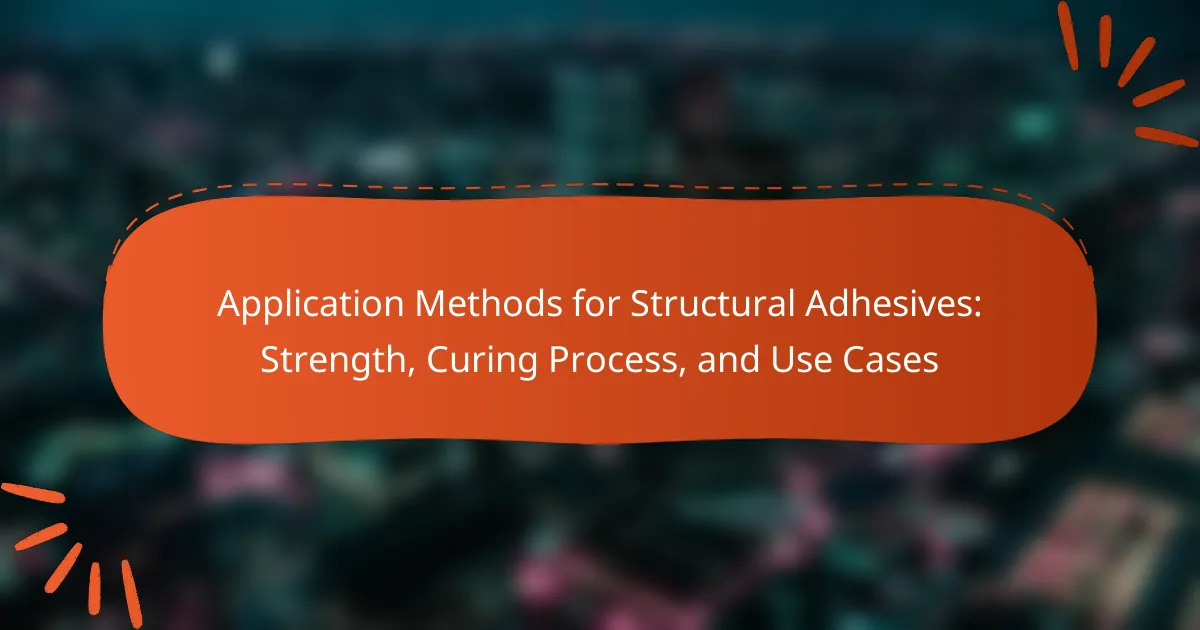Anaerobic adhesives are specialized bonding agents that cure in the absence of air, making them ideal for locking, sealing, and bonding metal surfaces. This article covers the application methods of anaerobic adhesives, emphasizing the importance of surface preparation, which includes cleaning and removing contaminants to ensure strong adhesion. It details the bonding process, highlighting the need for proper clamping and the variability of cure times based on product specifications. Additionally, the article addresses common challenges such as inadequate surface preparation and environmental factors that can impact adhesive performance, providing solutions to optimize the bonding process in industries like automotive, aerospace, and manufacturing.

What are Anaerobic Adhesives and Their Application Methods?
Anaerobic adhesives are a type of bonding agent that cure in the absence of air. They are commonly used for locking, sealing, and bonding metal surfaces. These adhesives remain liquid until confined in a tight space without oxygen. Upon application, they polymerize to form a strong bond.
Application methods include surface preparation, where surfaces must be clean and free of contaminants. The adhesive is then applied directly to one surface. The parts are brought together, allowing the adhesive to fill any gaps. Clamping may be necessary during the curing process. Cure times can vary, typically ranging from a few minutes to several hours, depending on the specific product.
Anaerobic adhesives are widely used in automotive, aerospace, and manufacturing industries due to their reliability and strength.
How do anaerobic adhesives differ from other adhesive types?
Anaerobic adhesives cure in the absence of air, unlike other adhesive types that may require moisture or heat for curing. This unique property allows anaerobic adhesives to bond effectively in tight-fitting metal assemblies. They are often used in applications like thread locking and sealing. In contrast, epoxy or cyanoacrylate adhesives cure through different mechanisms, such as moisture absorption or chemical reaction with heat. Anaerobic adhesives typically offer high strength and resistance to chemicals and temperature variations. Their curing process begins when the adhesive is confined between two surfaces, which is different from the curing mechanisms of other adhesives. This specificity makes them ideal for industrial applications where durability is essential.
What are the chemical properties of anaerobic adhesives?
Anaerobic adhesives are characterized by their ability to cure in the absence of air. This unique property allows them to form strong bonds on metal surfaces. The curing process involves a chemical reaction that is initiated by the presence of metal ions. Anaerobic adhesives typically consist of acrylate compounds, which contribute to their bonding strength and durability. These adhesives exhibit low viscosity, allowing for easy application and [censured] into small gaps. They also demonstrate resistance to chemicals, moisture, and temperature fluctuations, enhancing their performance in various environments. The chemical stability of anaerobic adhesives ensures long-lasting bonds under stress.
Why are anaerobic adhesives preferred for certain applications?
Anaerobic adhesives are preferred for certain applications due to their ability to cure in the absence of air. This characteristic allows them to bond well to metal surfaces, which are often used in industrial applications. They provide strong, durable bonds that are resistant to moisture and chemicals. Anaerobic adhesives also minimize the risk of contamination from moisture during the curing process. Their low viscosity allows them to penetrate small gaps, ensuring a tight fit. Furthermore, they eliminate the need for additional curing agents or heat. This makes them convenient for various assembly processes. Their effectiveness in high-stress environments further enhances their suitability for specific applications.
What is the bonding process of anaerobic adhesives?
Anaerobic adhesives bond through a chemical reaction that occurs in the absence of air. When these adhesives are applied to surfaces, they remain in a liquid state. Once the surfaces are joined and air is excluded, the adhesive begins to cure. The curing process involves the polymerization of the adhesive, transforming it into a solid bond. This reaction typically requires the presence of metal ions, which act as catalysts. The bond forms quickly, often within minutes, depending on the specific formulation. Anaerobic adhesives are commonly used in applications such as thread locking and structural bonding due to their strength and durability.
How does surface preparation influence the bonding process?
Surface preparation significantly influences the bonding process of anaerobic adhesives. Proper surface preparation enhances the adhesive’s ability to bond effectively to the substrate. It involves cleaning, roughening, and sometimes priming the surface. Clean surfaces remove contaminants like oils and dust that can inhibit adhesion. Roughening increases the surface area for the adhesive to grip, improving mechanical interlocking. Studies show that surfaces treated with appropriate methods can increase bond strength by up to 50%. Therefore, inadequate preparation can lead to weak bonds and premature failure.
What are the steps involved in applying anaerobic adhesives?
The steps involved in applying anaerobic adhesives include surface preparation, adhesive application, assembly, and curing. First, ensure surfaces are clean and free from contaminants. This can be done using solvents or abrasives. Next, apply the anaerobic adhesive evenly to one surface. Use the recommended amount for optimal bonding. After application, assemble the parts within the specified working time. Proper alignment is crucial for effective bonding. Finally, allow the adhesive to cure without interference. Curing times vary based on adhesive type and environmental conditions. Following these steps ensures a strong and effective bond.
What factors affect the cure time of anaerobic adhesives?
The cure time of anaerobic adhesives is affected by several factors. These factors include the type of adhesive used, the temperature of the environment, and the presence of contaminants on the bonding surfaces. Different formulations of anaerobic adhesives have varying cure times, with some designed for rapid curing. Higher temperatures generally accelerate the curing process, while lower temperatures can prolong it. Contaminants, such as oils or dust, can hinder adhesion and extend cure time, as they may prevent the adhesive from properly contacting the surfaces. Additionally, the thickness of the adhesive layer influences cure time; thicker layers may take longer to cure fully.
How does temperature impact the curing process?
Temperature significantly impacts the curing process of anaerobic adhesives. Higher temperatures generally accelerate the curing reaction. This leads to shorter cure times, enhancing productivity. Conversely, lower temperatures slow down the curing process. In extreme cold, curing may be delayed or even halted. The optimal temperature range for most anaerobic adhesives is typically between 20°C and 30°C. At these temperatures, the adhesives achieve their maximum strength and performance. Research indicates that every 10°C increase in temperature can double the curing speed. Thus, temperature control is crucial for effective adhesive bonding.
What role does the type of substrate play in cure time?
The type of substrate significantly influences the cure time of anaerobic adhesives. Different substrates have varying surface energies and porosities. High-energy surfaces, like metals, promote faster curing due to better adhesive interaction. In contrast, low-energy surfaces, such as plastics, may slow down the cure time. Additionally, porous substrates can absorb adhesive, affecting the overall curing process. Research indicates that the chemical composition of the substrate can also alter the curing rate. For example, studies show that anaerobic adhesives cure more quickly on steel compared to rubber. This demonstrates that substrate selection is crucial for optimizing adhesive performance and cure time.

How to Prepare Surfaces for Anaerobic Adhesives?
To prepare surfaces for anaerobic adhesives, clean the surfaces thoroughly. Remove all contaminants such as oil, grease, dust, and moisture. Use a suitable solvent like isopropyl alcohol for cleaning. Ensure the surface is dry before application. Abrade the surface if necessary to enhance adhesion. This can be done using sandpaper or a file. Finally, ensure the surfaces fit tightly together for optimal bonding. Proper surface preparation is critical for achieving maximum adhesive strength.
What surface conditions are optimal for adhesion?
Optimal surface conditions for adhesion include cleanliness, roughness, and appropriate moisture levels. Clean surfaces allow for better contact between adhesive and substrate. Contaminants such as oils or dust can hinder adhesion. A rough surface increases the surface area for bonding, enhancing mechanical interlocking. Studies show that surface roughness can significantly improve adhesive strength. Additionally, moisture content affects adhesion; too much moisture can weaken bonds, while some moisture can aid in adhesion for specific adhesives. Proper surface preparation is crucial for maximizing adhesion effectiveness.
How can contaminants affect adhesion quality?
Contaminants can significantly reduce adhesion quality. They create a barrier between the adhesive and the substrate. This barrier prevents proper bonding. Common contaminants include oils, dust, and moisture. Each of these can interfere with the adhesive’s ability to cure and form a strong bond. For instance, oil residues can prevent the adhesive from wetting the surface effectively. Research shows that cleanliness is critical for achieving optimal adhesion. A study published in the “Journal of Adhesion Science and Technology” found that surfaces free from contaminants had adhesion strength up to 50% higher than contaminated surfaces. Thus, ensuring a clean surface is essential for effective adhesion.
What cleaning methods are most effective for surface preparation?
Effective cleaning methods for surface preparation include solvent cleaning, abrasive cleaning, and chemical cleaning. Solvent cleaning removes oils and contaminants using solvents like acetone or isopropyl alcohol. Abrasive cleaning involves physical methods such as sanding or grinding to create a rough surface. Chemical cleaning uses specific chemicals to dissolve contaminants. According to the American National Standards Institute (ANSI), proper cleaning is crucial for optimal adhesion in bonding processes. Studies show that cleaned surfaces enhance the performance of anaerobic adhesives by ensuring better contact and reducing failure rates.
What tools and techniques enhance surface preparation?
Tools such as grinders, sanders, and shot blasters enhance surface preparation. Grinders remove rust and old coatings effectively. Sanders smooth surfaces and prepare them for adhesion. Shot blasters clean surfaces by removing contaminants. Techniques like chemical cleaning and abrasive blasting also improve surface quality. Chemical cleaning eliminates oils and residues, ensuring better adhesion. Each method increases surface roughness, enhancing bond strength. Studies show that proper surface preparation can improve adhesive bond strength by up to 50%.
How do mechanical methods compare to chemical methods in surface preparation?
Mechanical methods involve physical processes to prepare surfaces, while chemical methods rely on chemical reactions. Mechanical preparation includes sanding, grinding, or blasting to create a rough surface. This enhances adhesion by increasing the surface area. Chemical methods often involve solvents or etchants to clean or modify surfaces. They can remove contaminants and promote bonding at a molecular level.
Mechanical methods typically provide immediate results but can generate debris. In contrast, chemical methods may require longer application times but offer precise surface modification. Mechanical methods are often more labor-intensive. Chemical methods can be more effective for specific materials or contaminants. Each method has its advantages depending on the surface type and desired outcome.
What best practices should be followed for effective surface preparation?
Effective surface preparation involves cleaning, roughening, and ensuring the surface is free from contaminants. Cleaning removes dirt, grease, and old adhesive residues. This can be achieved using solvents or detergents specific to the materials involved. Roughening increases the surface area for better adhesion. Techniques include sanding, grinding, or using abrasive pads. Ensuring the surface is free from moisture is crucial. Moisture can weaken the bond formed by anaerobic adhesives. Testing the surface after preparation can confirm readiness for adhesive application. Following these practices leads to optimal bonding performance.

What are the Common Challenges and Solutions in Using Anaerobic Adhesives?
Common challenges in using anaerobic adhesives include inadequate surface preparation, improper cure time, and environmental factors. Inadequate surface preparation can lead to weak bonds. Solutions involve thorough cleaning and roughening of surfaces before application. Improper cure time can result in incomplete bonding. Following manufacturer guidelines for cure time is essential for optimal performance. Environmental factors like temperature and humidity can affect adhesion. Maintaining controlled conditions during application can mitigate these issues.
What troubleshooting tips can help with bonding issues?
Ensure surfaces are clean and free of contaminants. Contaminants can inhibit adhesion. Use solvents to remove oils and dust. Check the fit of components; gaps can lead to weak bonds. Apply the adhesive evenly for optimal coverage. Follow the manufacturer’s recommended cure time. Insufficient curing can weaken the bond. Store adhesives properly to maintain their effectiveness. Temperature and humidity can affect performance.
How can improper surface preparation lead to adhesive failure?
Improper surface preparation can lead to adhesive failure by preventing effective bonding between surfaces. Contaminants such as dust, oil, or moisture can disrupt the adhesive’s ability to adhere. Inadequate surface roughness may also reduce the mechanical interlocking needed for a strong bond. Additionally, insufficient cleaning can leave residues that weaken the adhesive’s performance. Studies show that surfaces prepared with proper techniques enhance bond strength significantly. For instance, a study published in the Journal of Adhesion Science and Technology found that surface contamination reduced bond strength by up to 50%. Proper surface preparation is crucial for achieving optimal adhesive performance.
What are the signs of inadequate curing in anaerobic adhesives?
Signs of inadequate curing in anaerobic adhesives include weak bond strength and incomplete adhesion. A weak bond may result in the parts being easily separated under stress. Incomplete adhesion can lead to visible gaps between the surfaces. Additionally, the adhesive may remain tacky or soft to the touch. Discoloration or a cloudy appearance can indicate improper curing. Lastly, the presence of unreacted adhesive can be observed, which suggests that the curing process was not fully completed. Each of these signs points to issues with the curing process, affecting the overall performance of the adhesive.
What are the best practices for successful application of anaerobic adhesives?
The best practices for successful application of anaerobic adhesives include proper surface preparation, correct adhesive selection, and optimal application techniques. Surface preparation involves cleaning and degreasing the surfaces to remove contaminants. This ensures maximum adhesion. The adhesive should be selected based on the materials being bonded and the application’s requirements. Application techniques must include even distribution of the adhesive to avoid gaps. Additionally, maintaining the recommended cure time is crucial for achieving strong bonds. Following these practices increases the effectiveness of anaerobic adhesives in various applications.
How can users ensure a strong bond with anaerobic adhesives?
Users can ensure a strong bond with anaerobic adhesives by properly preparing the surfaces to be bonded. Clean surfaces remove contaminants that can weaken adhesion. Use a suitable solvent or cleaner to degrease the surfaces. Ensure that surfaces are dry before applying the adhesive. Anaerobic adhesives require an absence of oxygen to cure effectively. Apply the adhesive evenly to one surface for optimal contact. Clamp or hold the parts together to maintain pressure during curing. Follow the manufacturer’s recommendations for cure time to achieve maximum strength. Proper surface preparation and application techniques enhance the bond strength significantly.
What common mistakes should be avoided during application?
Common mistakes to avoid during the application of anaerobic adhesives include inadequate surface preparation. Proper cleaning of surfaces ensures optimal bonding. Failing to remove contaminants like dust and grease can weaken the bond. Another mistake is applying too much adhesive. Excessive amounts can lead to improper curing and reduced strength. Users often overlook the cure time required for the adhesive to reach full strength. Not allowing sufficient time for curing can result in bond failure. Additionally, applying adhesive in extreme temperatures can affect performance. Each adhesive has specific temperature ranges for effective application. Lastly, neglecting to follow the manufacturer’s instructions can lead to improper usage. Adhering to guidelines ensures the best results.
Anaerobic adhesives are specialized bonding agents that cure in the absence of air, making them ideal for locking, sealing, and bonding metal surfaces. This article provides a comprehensive overview of their application methods, including essential surface preparation, the bonding process, and factors influencing cure time. Key topics include the unique chemical properties of anaerobic adhesives, optimal surface conditions for adhesion, and common challenges faced during their use. Additionally, best practices for effective application and troubleshooting tips for bonding issues are discussed to ensure strong and durable adhesive connections.


